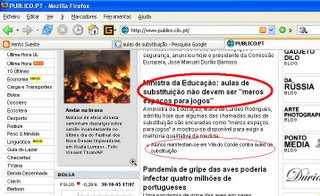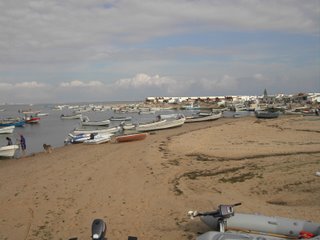Uma possível explicação seria aplicar a questão a outra coisa qualquer, p.ex. "Se a produção de pranchas de surf é um negócio viável, porque é que os criadores de perus não se dedicam a ela?". E a resposta é... porque os criadores de perus estão no negócio da criação de perus, não no negócio das pranchas de surf. Da mesma maneira, os bancos convencionais estão no negócio dos empréstimos com garantia, não no dos empréstimos sem garantia (p.ex., quando foi pedir um empréstimo para uma casa, assim que disse que tinha um contrato a prazo, disseram-me logo "Então, só com fiador").
Veja-se que, quando o então presidente Jorge Sampaio criticou os bancos por não apostarem no desenvolvimento de "empresas inovadores", muita gente respondeu que esse tipo de investimento não era a vocação dos bancos, mas do capital de risco.
Da mesma forma, parece que os pequenos empréstimos sem garantias não são o ramo dos bancos "convencionais", mas sim dos bancos de "micro-crédito", por um lado, e dos chamados "agiotas", por outro.
Mas mantêm-se as questões: como é que o micro-crédito consegue cobrar juros muito menores que os agiotas (tecnicamente, os agiotas também são micro-crédito, mas, neste post, vou usar a designação para entidades do estilo do Grameen Bank)? E porque é que o micro-crédito tende a ser oferecido, não por empresas "capitalistas" clássicas, mas através de associações sem fins lucrativos, ou de bancos propriedade dos seus clientes (no fundo, uma espécie de "cooperativas de consumo" aplicadas ao produto crédito)?
A respeito do micro-crédito ser mais barato que os agiotas, penso que não é dificil explicar - imagine-se que eu emprestava dinheiro a juros de 20% e que, p.ex., 95% dos meus clientes me pagavam (para simplificar, vamos supor que só há duas hipótese - pagar tudo ou não pagar nada). Em média, teria um rendimento de 14% (já que 95% dos clientes pagam 120% do valor emprestado e 5% não pagam); mas isto é uma média - tanto pode haver um rendimento de 120% (se todos pagarem), como de 0% (se nehum pagar).
Agora, vamos imaginar alguêm que empreste dinheiro nestas condições a 30 pessoas; já sabemos que, em média, terá um rendimento de 14%, mas qual será a probabilidade de ter prejuizo? O "agiota" terá prejuizo se mais de 5 clientes não pagarem; ora, se a probabalidade de cada um não pagar é de 5%, a probabilidade de, num grupo de 30 devedores, 5 ou mais não pagarem é de 1,56%; mas, num grupo de 3.000 devedores, a probabilidade de 500 ou mais não pagarem é praticamente zero. Ou seja, a quanto menos clientes se emprestar dinheiro, mais arriscado é o negócio, logo, um "agiota de aldeia" tenderá a exigir um juro mais elevado para compensar os riscos de perdas do que um banco com dezenas de milhares de clientes.
Outro factor (se calhar mais importante que o anterior, não faço ideia) é que, em paises pobres, há pouca gente com dinheiro disponivel para emprestar; ainda por cima, no caso de empréstimos com poucas garantias, é pouco provável que vão emprestar dinheiro a alguêm que não conheçam de lado nenhum. Logo, um camponês de uma aldeia do Bangladesh que queira pedir dinheiro emprestado só teria uma ou duas pessoas a quem recorrer, o que permite aos agiotas usar a sua situação de oligopólio local para cobrar juros elevados (claro que o GB também terá uma situação de quase-monopólio no seu ramo, mas como é propriedade dos seus clientes, não tem interesse em os "depenar").
Agora, há ainda mais um ponto: a tendência para juros altos reforça-se a si mesma - afinal, quando maior é a taxa de juro, maior é a probabilidade de o devedor não conseguir pagar o empréstimo, logo mais elevada tem que ser a taxa de juro para compensar o risco acrescido. Assim, até é possível que este mecanismo de feedback positivo leve a que pequenas alterações nas outras determinantes do nível de juros gerem alterações significativas na taxa de juro final.
Esta parte é mais ou menos consensual. Agora vamos à parte mais complicada - porque é que não surgem (ou surgem pouco) bancos "for profit" especializados na área do micro-crédito? Esta é parte em que vou "inventar". Talvez esta explicação faça algum sentido:
Imaginemos um banco comercial "clássico". Este tenderá a estabelecer o juro dos seus empréstimos pela seguinte regra:
juro dos empréstimos = juro dos depósitos + probabilidade de incumprimento + lucro esperado + outros custos
Como é que a "probabilidade de incumprimento" afecta a taxa de juro dos empréstimos? De duas maneiras: por um lado, a maneira óbvia (e claramente expressa na fórmula) - quanto mais elevada a probabilidade de incumprimento, mais elevado tem que ser o juro dos empréstimos para compensar os que não são pagos; e há outra possível ligação - um banco que se dedique a empréstimos de alto risco tenderá a querer um lucro mais elevado para compensar esses riscos (no fundo, o que já foi dito há uns parágrafos atrás), logo o "juro dos empréstimos" será maior também porque o "lucro esperado" será maior.
Qual é a diferença de um banco propriedade dos seus devedores, ou de uma associação sem fins lucrativos, face a um banco comercial, nesse aspecto? É que a relação "maior risco ==> exigir maior lucro" não é tão forte: afinal, maior lucro significa cobrar mais juros aos devedores do banco (que foi criado, exactamente, para seu beneficio), logo, não há grande interesse nisso (ou, vendo as coisas noutra prespectiva, podemos dizer que um banco propriedade dos devedores distribui os seus "lucros" pelos acionistas sob a forma de juros mais baixos).
Pode-se argumentar que o Grameen Bank não cobra juros mais baixos que os outros bancos - empresta é a clientes potencialmente mais arriscados. Mas vai dar ao mesmo: cobrar juros mais baixos a clientes com o mesmo risco de crédito, ou cobrar juros "não mais altos" a clientes com maior risco de crédito vai dar mais ou menos ao mesmo.
Outro contra-argumento é que o micro-crédito não é assim tão arriscado: afinal, o seu grau de incumprimento até é menor que o dos bancos "tradicionais"; mas o ponto é que, em empréstimos sem hipoteca, o incumprimento significa que o banco perde todo o dinheiro que emprestou (em compensação, se eu deixar de pagar o meu empréstimo, o prejuizo não é assim tão grande para o banco: sempre ficam com um apartamento em Portimão).
No New York Times, em 2001, Hal Varian também fez uma análise do micro-crédito e da razão porque a banca tradicional não entra nesse ramo. Talvez faça mais sentido que a minha...
Nota final: tal como disse no outro artigo, sempre publiquei este na terça-feira






